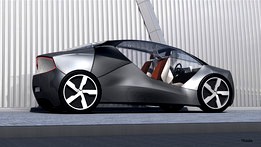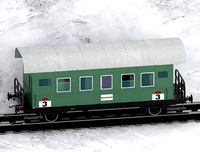GrabCAD

AVDSC
by GrabCAD
Last crawled date: 1 year, 10 months ago
AutoVisie (Dutch car magazine) issued a design contest in 2013. The goal was to create a vehicle for the year 2025. This was my entry which achieved the fourth place overall.
-----------------------------------------
In 2025, because of growing population and technological innovations, cities are expanding. More people will be living on smaller spaces. This means there is less space for the population to own a personal vehicle. Also, because of raising costs for owning a car, more people who could own a vehicle, will refrain from having one.
This means there will be a huge demand for taxi’s and public transport which will bring you to the exact location you want to be. The owner of the vehicle will buy the car itself, using it to drive customers about and in doing so earning his living and his investment back.
The car can also be used for business-transport. In 2025, large companies will be demanding for luxury vehicles to receive and transport their customers and important business-relations. Because of the modularity of the
vehicle, this car offers them a mobile meeting room where the driver can be isolated from the passengers.
Because the car will also be used by people who will have never been to the city they are, the roof will be used as an interactive map. Using head-up technology, a map of the city is projected onto the glass which shows where you are located now, and what interesting features are located in your neighbourhood.
The design of the car itself was influenced by the vision that, although the drivetrain gives a lot of flexibility
regarding proportions, 2025 is not long enough for people to accept radical new shapes. The proportions of the vehicle are therefore stretched, but still recognisable as a car we know today.
The car features a hydrogen fuel-cell drivetrain. The entire drivetrain is implemented in a skateboard-like structure at the bottom of the car. At the far end of this platform, four in-wheel engines drive the wheels of the vehicle. The wheels are placed fully outside of the passenger compartment, which gives the car its aggressive stance.
To gain access to the drivetrain and electrical compo¬nents, the panels above the wheels of the car open up. The boot is at the front of the vehicle, accessed by the trunk above the headlights. The flat drivetrain make that the floor of the car can be flat as well. Also, because the wheels are placed on the outer limits of the vehicle, the car can make use of every piece of space available. Because of this system, the vehicle is relatively high.
Instead of doors, the car features a fully-opening rear end, which provide access to the vehicle. To make sure the available space is maximally used, the vehicle uses a rail-system stretching the entire length of the interior. On this rail, six separate seats are placed, which can move and rotate individually. The passengers all enter from the rear of the car, get seated and the seats move to their final position.
The movable drive-by-wire steering-column adds to the modularity of the car. There is no need to convert the car for left- middle- or right-hand drive, the column slides to the required position. Also, because of the size of the vehicle and the rear-access, there is room to transport a wheelchair. The chair can then be hinged on the extending rear end of the rail, so it won’t move about.
To house all of the technology and passengers, the car has the following dimensions:
- Length: 4,9 m
- Width: 2,3 m
- Height: 1,8 m
-Wheelbase: 3,9 m
The panels are designed to be produced using simple production methods like injection-moulding and hydro¬forming. The panels are hinged and mounted on separate points, which make changing the panels after a crash or when you desire a different colour very easy.
The seats are produced using an injection-mould for the plastic rear, which will then be stuffed and lined. Because of the basic structure and assembly of the vehicle, the car itself is easy to dismantle. This means every body part is available for recycling.
The 1:20 aluminum model was processed and created by my colleagues at All in Plast at Oud-Beijerland, The Netherlands.
-----------------------------------------
In 2025, because of growing population and technological innovations, cities are expanding. More people will be living on smaller spaces. This means there is less space for the population to own a personal vehicle. Also, because of raising costs for owning a car, more people who could own a vehicle, will refrain from having one.
This means there will be a huge demand for taxi’s and public transport which will bring you to the exact location you want to be. The owner of the vehicle will buy the car itself, using it to drive customers about and in doing so earning his living and his investment back.
The car can also be used for business-transport. In 2025, large companies will be demanding for luxury vehicles to receive and transport their customers and important business-relations. Because of the modularity of the
vehicle, this car offers them a mobile meeting room where the driver can be isolated from the passengers.
Because the car will also be used by people who will have never been to the city they are, the roof will be used as an interactive map. Using head-up technology, a map of the city is projected onto the glass which shows where you are located now, and what interesting features are located in your neighbourhood.
The design of the car itself was influenced by the vision that, although the drivetrain gives a lot of flexibility
regarding proportions, 2025 is not long enough for people to accept radical new shapes. The proportions of the vehicle are therefore stretched, but still recognisable as a car we know today.
The car features a hydrogen fuel-cell drivetrain. The entire drivetrain is implemented in a skateboard-like structure at the bottom of the car. At the far end of this platform, four in-wheel engines drive the wheels of the vehicle. The wheels are placed fully outside of the passenger compartment, which gives the car its aggressive stance.
To gain access to the drivetrain and electrical compo¬nents, the panels above the wheels of the car open up. The boot is at the front of the vehicle, accessed by the trunk above the headlights. The flat drivetrain make that the floor of the car can be flat as well. Also, because the wheels are placed on the outer limits of the vehicle, the car can make use of every piece of space available. Because of this system, the vehicle is relatively high.
Instead of doors, the car features a fully-opening rear end, which provide access to the vehicle. To make sure the available space is maximally used, the vehicle uses a rail-system stretching the entire length of the interior. On this rail, six separate seats are placed, which can move and rotate individually. The passengers all enter from the rear of the car, get seated and the seats move to their final position.
The movable drive-by-wire steering-column adds to the modularity of the car. There is no need to convert the car for left- middle- or right-hand drive, the column slides to the required position. Also, because of the size of the vehicle and the rear-access, there is room to transport a wheelchair. The chair can then be hinged on the extending rear end of the rail, so it won’t move about.
To house all of the technology and passengers, the car has the following dimensions:
- Length: 4,9 m
- Width: 2,3 m
- Height: 1,8 m
-Wheelbase: 3,9 m
The panels are designed to be produced using simple production methods like injection-moulding and hydro¬forming. The panels are hinged and mounted on separate points, which make changing the panels after a crash or when you desire a different colour very easy.
The seats are produced using an injection-mould for the plastic rear, which will then be stuffed and lined. Because of the basic structure and assembly of the vehicle, the car itself is easy to dismantle. This means every body part is available for recycling.
The 1:20 aluminum model was processed and created by my colleagues at All in Plast at Oud-Beijerland, The Netherlands.
Similar models
grabcad
free

technitron
... to eight people, to typically have four wheels, and to be constructed principally for the transport of people rather than goods.
cg_trader
$5

A railway carriage from 1985
...or many secondary and local railways as well as small railways , passenger cars used to be called sidecars , analogous to trams .
3d_export
$48

engine case rear
...re efficient as it eliminates the need for the propeller shaft while the differential merges with the transmission to save space.
grabcad
free

Twisterana
...!
derived from the old beetle, the peoples’ car, this is an attempt to make the people friendly car which they would like to own!
grabcad
free

EFPV - Eletric Field Powered Vehicle
...ll information about the car end the other all information passenger want will be available at one unique display (touch screen)
cg_trader
free

toy car
...ly drive technology vehicle transport shipment delivery logistic toy funny standard standard car delivery truck toy car toy truck
cg_trader
$10

Passenger train car
...railway railroad logistics retro rail shipment technology logistic car wheel passenger train train car train carriage train wheel
3dwarehouse
free

RAF 22 031 ambulance
... victims of the accident at the chernobyl nuclear power plant in april 1986. #1980 #ambulance #cars #medical_equipment #raf #ussr
3dwarehouse
free

Endominium DisePanel
....ıllı.al.ıllı. of course, i changed the color of the rims and brushguard. #comercial #disepanel #endominium #panel #panelvan #van
grabcad
free

Car differential
...ent speeds. this would be the front wheels in front-wheel-drive, the rear in rear-wheel drive, and all wheels on all-wheel drive.
